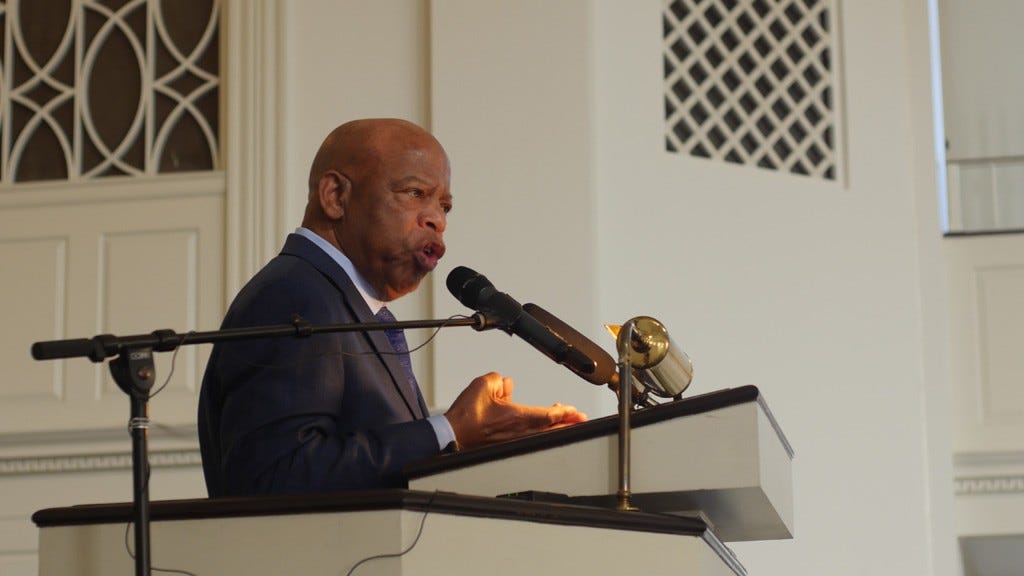John Lewis Showed Us The Way
Reflecting on the Legacy of a Giant
John Robert Lewis may have been a man of small stature, but he was a giant in the fight for “equal justice.” It was his life’s work to stand up for the oppressed - not because it was the politically advantageous thing to do, but because it was the right thing to do - leaving a legacy of compassion, good deeds, and a remarkable record of personal sacrifice in his wake. Having benefited from the examples of the civil rights legends who came before him, he was deliberate in his intention to mentor the next generation, to show them the way of peaceful, nonviolent resistance, knowing all too well that the road to true equality would be a long one.
John Lewis joined the civil rights movement early in life, unable to accept the moral wrong of having two sets of rules in American society - one for Whites, another for Blacks. At age 15, after hearing Martin Luther King Jr. on the radio, who spoke of the power of ordinary, disciplined people to make a difference, John made the monumental decision to join the Montgomery Bus Boycott and, by the age of 18, he’d met the man whose righteous voice inspired his future.
John Walked the Walk
As a member of the Student Nonviolent Coordinating Committee (SNCC), he helped organize the Nashville lunch counter sit-ins and pushed back against the “separate but equal” laws of the day as one of 13 original Freedom Riders (a group of 6 White activists and 7 Black). Those rides led him to Rock Hill, SC, where he sustained one of the many beatings he’d receive. He was beaten in Birmingham by the KKK and left unconscious following a blow to the head in Montgomery. But he was not deterred. As he often explained, “We were determined not to let any act of violence keep us from our goal.” He nursed his wounds and rose to stand his ground again and again and again.
The work of the SNCC eventually shifted to voter rights. In 1964, Rev. Hosea Williams and SNCC Chair John Lewis led 600 peaceful marchers across the Edmund Pettus Bridge in protest of Black voter suppression and intimidation. After stopping to pray, they were approached by a posse of state troopers, who tear-gassed and beat them so badly John “thought [he] saw death.” Public outrage over that Bloody Sunday event paved the way for the passage of the 1965 Civil Rights Act.
The fight to end the Jim Crow practice of segregation stands alone in its historical significance. And yet, the language of that era is sadly evergreen. Lewis, in his 1963 March on Washington speech, called for the “end of starvation wages or no wages at all” and for the right of every qualified voter to cast their ballot without interference. He denounced the jailing of human beings on “trumped-up charges” and demanded an end to police brutality and the evils of injustice. In his first speech draft, he posed the question many of us are asking ourselves today, “Which side is the federal government on?”
Lewis Tirelessly Served the Public

In 1986, Lewis won a seat in the US House of Representatives, where he continued to impact change and where he remained for the rest of his life. Never missing an opportunity to shine light on things he believed to be wrong, he was affectionately called the Conscience of Congress. In that legislative role, he proved to be a friend of the Jewish and LGBT communities and participated in a 2013 sit-in for immigrant rights. After blocking traffic while chanting, “Si, su puede!” more than 100 demonstrators were arrested, including Rep. Lewis and seven of his (D) colleagues.
While volunteering for Kathy Manning’s 2018 run for Congress, I had the great pleasure of hearing Rep. Lewis speak on the campus of HBC Bennett College. He said that day, “I have been beaten, my skull fractured, and arrested more than 40 times so that each and every person has the right to vote.” To students in the audience, he shouted, “Get out there and vote like you've never voted before!” He ended his speech by, of course, urging us all to do our parts — to recognize and stand firmly against oppression and abuse in all of its forms. And telling us, as he’d told so many before, that it was our duty and obligation to “Get in good trouble, necessary trouble” when we saw something we knew to be wrong.
Now It’s Our Turn
In a posthumous letter to the American people, published on the day of his funeral by the New York Times, John Lewis - a moral icon and the very embodiment of hope – got the final word:
“Though I may not be here with you, I urge you to answer the highest calling of your heart and stand up for what you believe in. When historians pick up their pens to write the story of the 21st century, let them say it was your generation who laid down the heavy burden of hate at last…Walk with the wind, brothers and sisters.”
Remember that “the way of love and nonviolence is the more excellent way.”
Call to Action
On Thursday, July 17th, the 5-year anniversary of Representative John Lewis’s passing, there will be a mass action of peaceful, nonviolent protest to denounce the injustices, inhumanity, and assaults on our freedoms by the Trump administration.
Stand up, speak up at an event near you! #GoodTroubleLivesOn





Great tribute and CTA, Bren!
Hopefully 🙏🏾 the Latinos, Asians and Europeans show up in great numbers to stop this evil regime. I’m with y’all in spirit. Rest in Power my brother and we thank you for everything you did for us. 🖤🖤🖤🖤🖤🖤🖤🖤🖤🖤